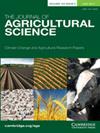Effects of COVID-19 on Food Demand in Rural Indonesia: The Case of Bengkulu Province
IF 1.7
4区 农林科学
Q2 AGRICULTURE, MULTIDISCIPLINARY
引用次数: 0
Abstract
This paper examines food demand before and after the outbreak of COVID-19 and studies the effects of the situation on households’ demand for food in rural Indonesia, in the case of Bengkulu Province. The research data is taken from the Indonesia Socio-Economic Survey (SUSENAS) as a microdata set which is collected annually by Indonesia Central Statistics Agency (BPS) from 2017 to 2021. The effect of COVID-19 on food demand estimates using the Quadratic Almost Ideal Demand System (QUAIDS). The results demonstrate that prepared food expenditure is the largest portion of household expenditure on food in the Bengkulu rural area. Before the outbreak of COVID-19, animal source food is the most sensitive to food expenditure, but after the outbreak, prepared food is the most sensitive. Staple food is the most expenditure-inelastic before and after the outbreak. Expenditure for animal source food, vegetables & fruits, and prepared food have significant differences between before and after the outbreak. All the food groups substitute for each other before the outbreak, whereas staple food and prepared food cannot be regarded as a substitute for each other after the outbreak. There are eleven of the compensated price elasticities whose differences between before and after the outbreak are significant, whereas as a set the compensated price elasticities are significantly different between before and after the outbreak. Other food is the easiest to be substituted for both phases. Prepared food is the most difficult to be substituted before the outbreak, but the staple food is the most difficult to be substituted after the outbreak. After the outbreak of COVID-19, the demand for vegetables & fruits increases, but the demand for staple food and prepared food decreases, ceteris paribus. Family size, children, gender, age, and other demographics variables have an impact on household food demand. These findings imply that after the outbreak, the supply of vegetables & fruits should be increased and that government support for suppliers of staple food and prepared food will be preferable.2019冠状病毒病对印度尼西亚农村粮食需求的影响:以明古鲁省为例
本文考察了2019冠状病毒病爆发前后的粮食需求,并以明古鲁省为例,研究了疫情对印度尼西亚农村家庭粮食需求的影响。研究数据来自印度尼西亚社会经济调查(SUSENAS)作为微观数据集,由印度尼西亚中央统计局(BPS)从2017年至2021年每年收集。利用二次几乎理想需求系统(QUAIDS)估算COVID-19对粮食需求的影响。结果表明,在Bengkulu农村地区,预制食品支出是家庭食品支出的最大部分。疫情爆发前,动物源食品对食物支出最敏感,疫情爆发后,预制食品对食物支出最敏感。主食是疫情前后支出弹性最大的食品。动物源食品、蔬菜和水果以及预制食品的支出在疫情前后存在显著差异。在疫情爆发前,所有食品类别都是相互替代的,而在疫情爆发后,主食和熟食不能相互替代。有11个补偿价格弹性在爆发前后差异显著,而作为一个集合,补偿价格弹性在爆发前后差异显著。其他食物最容易代替这两个阶段。预制食品是疫情前最难替代的,而主食是疫情后最难替代的。疫情爆发后,蔬菜和水果需求增加,但主食和熟食需求减少,其他条件不变。家庭规模、子女、性别、年龄和其他人口统计变量对家庭粮食需求有影响。这些结果表明,疫情发生后,应增加蔬菜和水果的供应,政府对主食和熟食供应商的支持将是可取的。
本文章由计算机程序翻译,如有差异,请以英文原文为准。
求助全文
约1分钟内获得全文
求助全文
来源期刊

Journal of Agricultural Science
农林科学-农业综合
CiteScore
2.80
自引率
5.00%
发文量
68
审稿时长
1.4 months
期刊介绍:
The Journal of Agricultural Science publishes papers concerned with the advance of agriculture and the use of land resources throughout the world. It publishes original scientific work related to strategic and applied studies in all aspects of agricultural science and exploited species, as well as reviews of scientific topics of current agricultural relevance. Specific topics of interest include (but are not confined to): all aspects of crop and animal physiology, modelling of crop and animal systems, the scientific underpinning of agronomy and husbandry, animal welfare and behaviour, soil science, plant and animal product quality, plant and animal nutrition, engineering solutions, decision support systems, land use, environmental impacts of agriculture and forestry, impacts of climate change, rural biodiversity, experimental design and statistical analysis, and the application of new analytical and study methods (including genetic diversity and molecular biology approaches). The journal also publishes book reviews and letters. Occasional themed issues are published which have recently included centenary reviews, wheat papers and modelling animal systems.
 求助内容:
求助内容: 应助结果提醒方式:
应助结果提醒方式:


